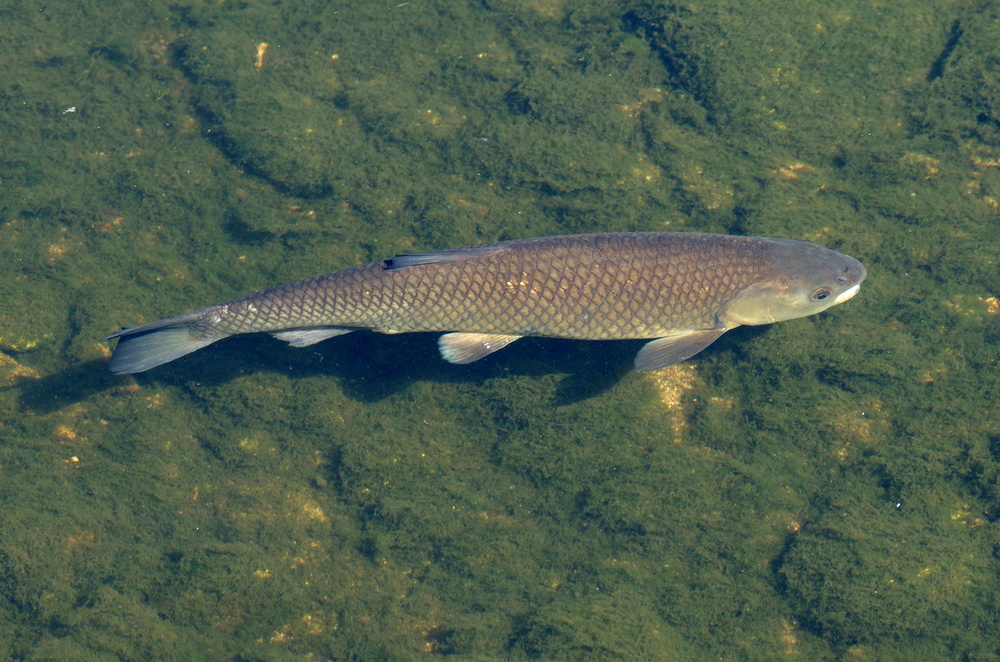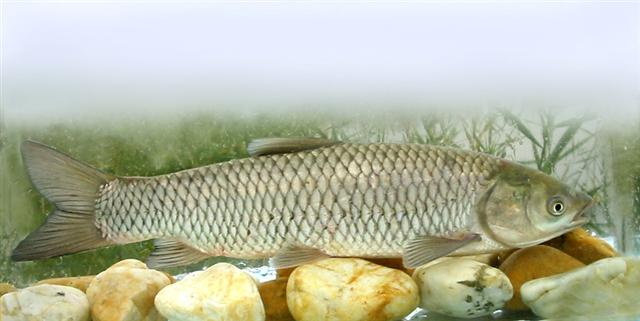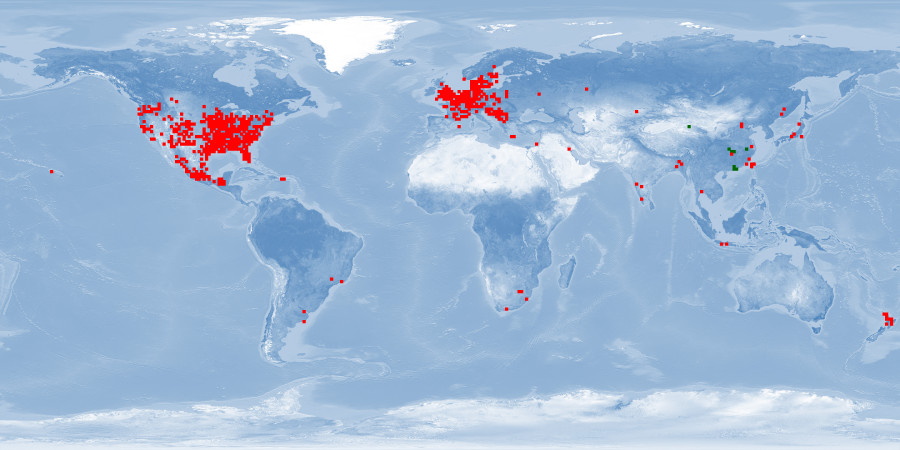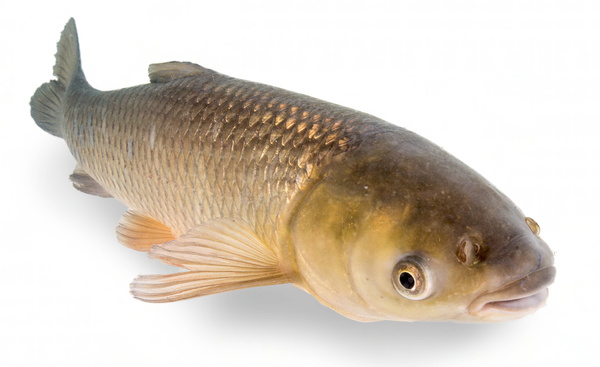
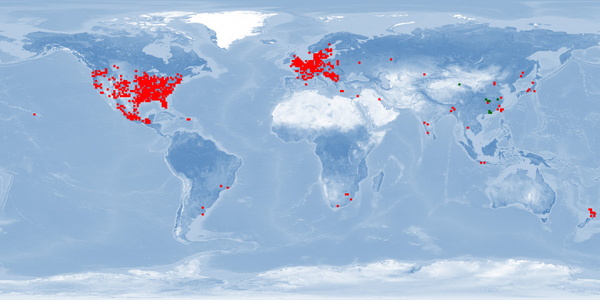
Information
Version: B | 1.4 (2022-07-29)
WelfareScore | farm
Condensed assessment of the species' likelihood and potential for good fish welfare in aquaculture, based on ethological findings for 10 crucial criteria.
- Li = Likelihood that the individuals of the species experience good welfare under minimal farming conditions
- Po = Potential of the individuals of the species to experience good welfare under high-standard farming conditions
- Ce = Certainty of our findings in Likelihood and Potential
WelfareScore = Sum of criteria scoring "High" (max. 10)
General remarks
Ctenopharyngodon idella is a native Chinese freshwater fish with a widespread distribution and considered one of the four Chinese major carps (among Hypophthalmichthys molitrix, H. nobilis, and Mylopharyngodon piceus). This species has been introduced into more than 50 countries throughout the world for aquatic weed control and aquaculture. In some countries, the Grass carp is an integral part of fish culture and forms an important source of protein for human consumption. Due to its success it is the third most commonly cultured species in the world. However, further research is needed on current farming conditions relating to reproduction without manipulation, aggregation, aggression, stress, and the current harvesting practices. Carp welfare can be improved using extensive culture systems promoting a natural habitat and behaviour of the species.
1 Home range
Many species traverse in a limited horizontal space (even if just for a certain period of time per year); the home range may be described as a species' understanding of its environment (i.e., its cognitive map) for the most important resources it needs access to.
What is the probability of providing the species' whole home range in captivity?
It is low for minimal farming conditions. It is high for high-standard farming conditions. Our conclusion is based on a medium amount of evidence.


2 Depth range
Given the availability of resources (food, shelter) or the need to avoid predators, species spend their time within a certain depth range.
What is the probability of providing the species' whole depth range in captivity?
It is low for minimal farming conditions. It is high for high-standard farming conditions. Our conclusion is based on a medium amount of evidence.


3 Migration
Some species undergo seasonal changes of environments for different purposes (feeding, spawning, etc.), and to move there, they migrate for more or less extensive distances.
What is the probability of providing farming conditions that are compatible with the migrating or habitat-changing behaviour of the species?
It is low for minimal farming conditions. It is medium for high-standard farming conditions. Our conclusion is based on a medium amount of evidence.


4 Reproduction
A species reproduces at a certain age, season, and sex ratio and possibly involving courtship rituals.
What is the probability of the species reproducing naturally in captivity without manipulation of theses circumstances?
It is low for minimal farming conditions. It is medium for high-standard farming conditions. Our conclusion is based on a low amount of evidence.


5 Aggregation
Species differ in the way they co-exist with conspecifics or other species from being solitary to aggregating unstructured, casually roaming in shoals or closely coordinating in schools of varying densities.
What is the probability of providing farming conditions that are compatible with the aggregation behaviour of the species?
It is low for minimal farming conditions. It is medium for high-standard farming conditions. Our conclusion is based on a medium amount of evidence.


6 Aggression
There is a range of adverse reactions in species, spanning from being relatively indifferent towards others to defending valuable resources (e.g., food, territory, mates) to actively attacking opponents.
What is the probability of the species being non-aggressive and non-territorial in captivity?
There are no findings for minimal and high-standard farming conditions.


7 Substrate
Depending on where in the water column the species lives, it differs in interacting with or relying on various substrates for feeding or covering purposes (e.g., plants, rocks and stones, sand and mud, turbidity).
What is the probability of providing the species' substrate and shelter needs in captivity?
It is low for minimal farming conditions. It is medium for high-standard farming conditions. Our conclusion is based on a low amount of evidence.


8 Stress
Farming involves subjecting the species to diverse procedures (e.g., handling, air exposure, short-term confinement, short-term crowding, transport), sudden parameter changes or repeated disturbances (e.g., husbandry, size-grading).
What is the probability of the species not being stressed?
It is low for minimal farming conditions. It is medium for high-standard farming conditions. Our conclusion is based on a low amount of evidence.


9 Malformations
Deformities that – in contrast to diseases – are commonly irreversible may indicate sub-optimal rearing conditions (e.g., mechanical stress during hatching and rearing, environmental factors unless mentioned in crit. 3, aquatic pollutants, nutritional deficiencies) or a general incompatibility of the species with being farmed.
What is the probability of the species being malformed rarely?
It is low for minimal farming conditions. It is medium for high-standard farming conditions. Our conclusion is based on a low amount of evidence.


10 Slaughter
The cornerstone for a humane treatment is that slaughter a) immediately follows stunning (i.e., while the individual is unconscious), b) happens according to a clear and reproducible set of instructions verified under farming conditions, and c) avoids pain, suffering, and distress.
What is the probability of the species being slaughtered according to a humane slaughter protocol?
It is low for minimal farming conditions. It is medium for high-standard farming conditions. Our conclusion is based on a medium amount of evidence.


Side note: Domestication
Teletchea and Fontaine introduced 5 domestication levels illustrating how far species are from having their life cycle closed in captivity without wild input, how long they have been reared in captivity, and whether breeding programmes are in place.
What is the species’ domestication level?
DOMESTICATION LEVEL 5 39, fully domesticated.
Side note: Forage fish in the feed
450-1,000 milliard wild-caught fishes end up being processed into fish meal and fish oil each year which contributes to overfishing and represents enormous suffering. There is a broad range of feeding types within species reared in captivity.
To what degree may fish meal and fish oil based on forage fish be replaced by non-forage fishery components (e.g., poultry blood meal) or sustainable sources (e.g., soybean cake)?
All age classes: WILD: herbivorous 40 23. FARM: fish meal and fish oil my be partly* 17 27 41 or completely* replaced by non-forage fishery components 42. Further research needed to replicate complete replacement.
*partly = <51% – mostly = 51-99% – completely = 100%
Glossary
DOMESTICATION LEVEL 5 = selective breeding programmes are used focusing on specific goals 39
FARM = setting in farming environment or under conditions simulating farming environment in terms of size of facility or number of individuals
FRY = larvae from external feeding on, for details ➝ Findings 10.1 Ontogenetic development
IND = individuals
JUVENILES = fully developed but immature individuals, for details ➝ Findings 10.1 Ontogenetic development
LARVAE = hatching to mouth opening, for details ➝ Findings 10.1 Ontogenetic development
PELAGIC = living independent of bottom and shore of a body of water
POTAMODROMOUS = migrating within fresh water
SPAWNERS = adults during the spawning season; in farms: adults that are kept as broodstock
WILD = setting in the wild
Bibliography
2 Hockin, D. C., K. O’Hara, and J. W. Eaton. 1989. A radiotelemetric study of the movements of grass carp in a British canal. Fisheries Research 7: 73–84. https://doi.org/10.1016/0165-7836(89)90008-8.
3 Bain, Mark B., David H. Webb, Michael D. Tangedal, and Larry N. Mangum. 1990. Movements and Habitat Use by Grass Carp in a Large Mainstream Reservoir. Transactions of the American Fisheries Society 119: 553–561. https://doi.org/10.1577/1548-8659(1990)119<0553:MAHUBG>2.3.CO;2.
4 Shireman, Jerome V., Douglas E. Colle, and Roger W. Rottmann. 1978. Growth of grass carp fed natural and prepared diets under intensive culture. Journal of Fish Biology 12: 457–463. https://doi.org/10.1111/j.1095-8649.1978.tb04189.x.
5 Rottmann, Roger W., and Jerome V. Shireman. 1979. Tank spawning of grass carp. Aquaculture 17: 257–261. https://doi.org/10.1016/0044-8486(79)90129-7.
6 Shireman, J.V., and S.R. Smith. 1983. Synopsis of biological data on the grass carp Ctenopharyngodon idella (Cuvier and Valenciennes, 1844). 135. Centre for Aquatic Weeds University of Florida: Food and Agriculture Organization of the United Nations.
7 Froese, R., and D. Pauly. 2014. FishBase. World Wide Web electronic publication. www.fishbase.org.
8 Colle, Douglas E., Richard L. Cailteux, and Jerome V. Shireman. 1989. Distribution of Florida Largemouth Bass in a Lake after Elimination of All Submersed Aquatic Vegetation. North American Journal of Fisheries Management 9: 213–218. https://doi.org/10.1577/1548-8675(1989)009<0213:DOFLBI>2.3.CO;2.
9 Riede, K. 2004. Global register of migratory species - from global to regional scales. Final report of the R&D Projekt 808 05 081. Bonn, Germany: Federal Agency for Nature Conservation.
10 Guillory, Vincent, and Robert D. Gasaway. 1978. Zoogeography of the Grass Carp in the United States. Transactions of the American Fisheries Society 107: 105–112. https://doi.org/10.1577/1548-8659(1978)107<105:ZOTGCI>2.0.CO;2.
11 Moyle, P.B. 1986. Fish introductions into North America: patterns and ecological impact. In In H.A. Mooney and J.A. Drake, eds. Ecology of biological invasions of North America and Hawaii., Springer-Verlag, 27–43. New York.
12 Gorbach, E.I., and M.L. Krykhtin. 1988. Migration of the white amur, Ctenopharyngodon idella, and silver carp, Hypophthalmichthys molitrix, in the Amur River Basin. Journal Ichthyology 28: 47–53.
13 Culdmore, B, and N.E. Mandrak. 2004. Biological Synopsis of Grass Carp (Ctenopharyngodon idella). Canadian Manuscript Report of Fisheries and Aquatic Sciences: 44.
14 Raibley, P.T., K.D. Blodgett, and R.E. Sparks. 1995. Evidence of Grass Carp (Ctenopharyngodon idella) Reproduction in the Illinois and Upper Mississippi Rivers. Journal of Freshwater Ecology 10: 65–74. https://doi.org/10.1080/02705060.1995.9663418.
15 Federenko, A.Y., and F.J Fraser. 1978. Review of grass carp biology. Interagency Committee on Transplants and Introductions of Fish and Aquatic Invertebrates in British Columbia. 786. British Columbia, Department of Fisheries and Environment, Fisheries and Marine Service.
16 Stanley, Jon G., W. Woodard Miley, and David L. Sutton. 1978. Reproductive Requirements and Likelihood for Naturalization of Escaped Grass Carp in the United States. Transactions of the American Fisheries Society 107: 119–128. https://doi.org/10.1577/1548-8659(1978)107<119:RRALFN>2.0.CO;2.
17 Cai, X., L. Luo, M. Xue, X. Wu, and W. Zhan. 2005. Growth performance, body composition and phosphorus availability of juvenile grass carp (Ctenopharyngodon idellus) as affected by diet processing and replacement of fishmeal by detoxified castor bean meal. Aquaculture Nutrition 11: 293–299. https://doi.org/10.1111/j.1365-2095.2005.00354.x.
18 De Silva, S., G. Turchini, and D. Francis. 2003. Aquaculture: Farming Aquatic Animals and Plants, 2nd Edition. In , 276–294. Oxford, UK: Blackwell Publishing.
19 Buckley, B. R., and B. Stott. 1977. Grass Carp in a Sport Fishery. Aquaculture Research 8: 8–10. https://doi.org/10.1111/j.1365-2109.1977.tb00200.x.
20 Van Dyke, J.M., A.J. Leslie Jr., and L.E. Nall. 1984. The effects of Grass Carp on the Aquatic Macrophytes of Four Florida Lakes. J Aquat Plant Manage 22: 87–97.
21 Opuszynski, K., and J.V. Shireman. 1995. Herbivorous Fishes: Culture and Use for Weed Management. Boca Raton, Florida: CRC Press.
22 Pípalová, I. 2006. A review of grass carp use for aquatic weed control and itsimpact on water bodies. J. Aquat. Plant Manage 44: 1–12.
23 Li, Xiangsong, Xiaoming Zhu, Dong Han, Yunxia Yang, Junyan Jin, and Shouqi Xie. 2016. Carbohydrate utilization by herbivorous and omnivorous freshwater fish species: a comparative study on gibel carp (Carassius auratus gibelio. var CAS III) and grass carp (Ctenopharyngodon idellus). Aquaculture Research 47: 128–139. https://doi.org/10.1111/are.12476.
24 Chen, Yafen, Hongjie Sun, Wei Yang, and Zhou Yang. 2012. Incubation and oxidative stress of grass carp (Ctenopharyngodon idella) embryos exposed to different un-ionized ammonia levels. Journal of Freshwater Ecology 27: 143–150. https://doi.org/10.1080/02705060.2011.638529.
25 Jiang, Danli, Yubo Wu, Di Huang, Xing Ren, and Yan Wang. 2017. Effect of blood glucose level on acute stress response of grass carp Ctenopharyngodon idella. Fish Physiology and Biochemistry 43: 1433–1442. https://doi.org/10.1007/s10695-017-0383-y.
26 Cui, Yanting, Bo Liu, Jun Xie, Pao Xu, H.-Michael Habte-Tsion, and Yuanyuan Zhang. 2014. Effect of heat stress and recovery on viability, oxidative damage, and heat shock protein expression in hepatic cells of grass carp (Ctenopharyngodon idellus). Fish Physiology and Biochemistry 40: 721–729. https://doi.org/10.1007/s10695-013-9879-2.
27 Tian, Li Xia, Yong Jian Liu, Hui Jun Yang, Gui Ying Liang, and Jin Niu. 2012. Effects of different dietary wheat starch levels on growth, feed efficiency and digestibility in grass carp (Ctenopharyngodon idella). Aquaculture International 20: 283–293. https://doi.org/10.1007/s10499-011-9456-6.
28 Akar, AM. 2011. Effects of stress on spawners reproductive performance in female Grass Carp (Ctenopharyngodon idella). JOURNAL OF THE ARABIAN AQUACULTURE SOCIETY 6: 171,180.
29 Korwin-Kossakowski, M. 2008. The influence of temperature during the embryonic period on larval growth and development in carp, Cyprinus carpio L., and grass carp, Ctenopharyngodon idella (Val.): Theoretical and practical aspects. Archiwum Rybactwa Polskiego 16: 231–314.
30 Dabrowski, K., and P. Poczyczyński. 1988. Comparative experiments on starter diets for grass carp and common carp. Aquaculture 69: 317–332. https://doi.org/10.1016/0044-8486(88)90339-0.
31 Takeuchi, T., K Watanabe, W-Y Yong, and T. Watanabe. 1991. Essential fatty acids of grass carp Ctenopharyngodon idella. NIPPON SUISAN GAKKAISHI. Published by The Japanese Society of Fisheries Science. 57: 467–473.
32 Takeuchi, T. 1996. Essential fatty acid requirements in carp. Archiv Fur Tierernahrung 49: 23–32.
33 European Food Safety Authority (EFSA). 2009. Species-specific welfare aspects of the main systems of stunning and killing of farmed Carp. EFSA Journal 1013: 1–37. https://doi.org/10.2903/j.efsa.2009.1013.
34 Rahmanifarah, K., B. Shabanpour, and A. Sattari. 2011. Effects of Clove Oil on Behavior and Flesh Quality of Common Carp (Cyprinus carpio L.) in Comparison with Pre-slaughter CO2 Stunning, Chilling and Asphyxia. Turkish Journal of Fisheries and Aquatic Sciences 11: 139–147.
35 Retter, Karina, Karl-Heinz Esser, Matthias Lüpke, John Hellmann, Dieter Steinhagen, and Verena Jung-Schroers. 2018. Stunning of common carp: Results from a field and a laboratory study. BMC Veterinary Research 14: 1–11. https://doi.org/10.1186/s12917-018-1530-0.
36 Qin, Na, Dapeng Li, Hui Hong, Yuemei Zhang, Beiwei Zhu, and Yongkang Luo. 2016. Effects of different stunning methods on the flesh quality of grass carp (Ctenopharyngodon idellus) fillets stored at 4 °C. Food Chemistry 201: 131–138. https://doi.org/10.1016/j.foodchem.2016.01.071.
37 Zhang, L., Q. Li, J. Lyu, C. Kong, S. Song, and Y. Luo. 2016. The impact of stunning methods on stress conditions and quality of silver carp (Hypophthalmichthys molitrix) fillets stored at 4°C during 72h postmortem. Food chemistry 216: 130–137. https://doi.org/10.1016/j.foodchem.2016.08.004.
38 Zhang, L., Y. Zhang, S. Jia, Y. Li, Q. Li, K. Li, H. Hong, and Y. Luo. 2019. Stunning stress-induced textural softening in silver carp (Hypophthalmichthys molitrix) fillets and underlying mechanisms. Food Chemistry 295: 520–529. https://doi.org/10.1016/j.foodchem.2019.05.148.
39 Teletchea, Fabrice, and Pascal Fontaine. 2012. Levels of domestication in fish: implications for the sustainable future of aquaculture. Fish and Fisheries 15: 181–195. https://doi.org/10.1111/faf.12006.
40 Lin, D. 1991. Grass carp, Ctenopharyngodon idella. In Handbook of Nutrient Requirements of Finfish. In , 89–96. Boca Raton: FL: CRC Press.
41 Gan, L., X.-X. Li, Q. Pan, S.-L. Wu, T. Feng, and H. Ye. 2015. Effects of replacing soybean meal with faba bean meal on growth, feed utilization and antioxidant status of juvenile grass carp, Ctenopharyngodon idella. Aquaculture Nutrition 23: 192–200. https://doi.org/10.1111/anu.12380.
42 Fletcher, Rob. 2017. Fish-free feed shortlist revealed. Fsh Farming Expert.












